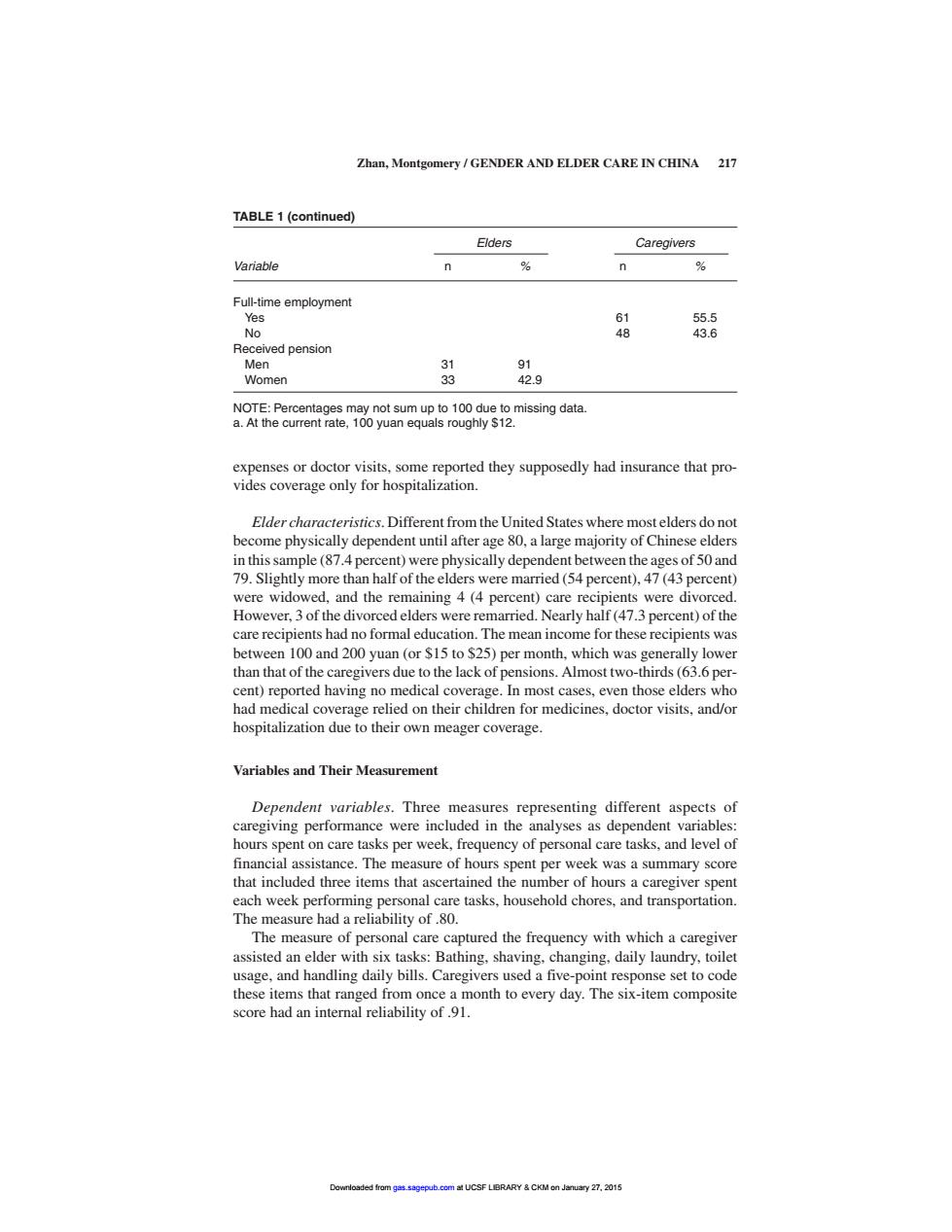正在加载图片...

Zhan,Montgomery GENDER AND ELDER CARE IN CHINA 217 TABLE 1(continued) Elders Caregivers Variable n % n % Full-time employment Yes 61 55.5 No 48 43.6 Received pension Men 31 91 Women 33 42.9 NOTE:Percentages may not sum up to 100 due to missing data. a.At the current rate,100 yuan equals roughly $12. expenses or doctor visits,some reported they supposedly had insurance that pro- vides coverage only for hospitalization. Elder characteristics.Different from the United States where most elders do not become physically dependent until after age 80,a large majority of Chinese elders in this sample(87.4 percent)were physically dependent between the ages of 50 and 79.Slightly more than half of the elders were married(54 percent),47(43 percent) were widowed,and the remaining 4(4 percent)care recipients were divorced. However,3 of the divorced elders were remarried.Nearly half(47.3 percent)of the care recipients had no formal education.The mean income for these recipients was between 100 and 200 yuan (or $15 to $25)per month,which was generally lower than that of the caregivers due to the lack of pensions.Almost two-thirds(63.6 per- cent)reported having no medical coverage.In most cases,even those elders who had medical coverage relied on their children for medicines,doctor visits,and/or hospitalization due to their own meager coverage. Variables and Their Measurement Dependent variables.Three measures representing different aspects of caregiving performance were included in the analyses as dependent variables: hours spent on care tasks per week,frequency of personal care tasks,and level of financial assistance.The measure of hours spent per week was a summary score that included three items that ascertained the number of hours a caregiver spent each week performing personal care tasks,household chores,and transportation. The measure had a reliability of.80. The measure of personal care captured the frequency with which a caregiver assisted an elder with six tasks:Bathing,shaving,changing,daily laundry,toilet usage,and handling daily bills.Caregivers used a five-point response set to code these items that ranged from once a month to every day.The six-item composite score had an internal reliability of.91. Downloaded from gas.sagepub.com at UCSF LIBRARY CKM on January 27.2015expenses or doctor visits, some reported they supposedly had insurance that provides coverage only for hospitalization. Elder characteristics. Different from the United States where most elders do not become physically dependent until after age 80, a large majority of Chinese elders in this sample (87.4 percent) were physically dependent between the ages of 50 and 79. Slightly more than half of the elders were married (54 percent), 47 (43 percent) were widowed, and the remaining 4 (4 percent) care recipients were divorced. However, 3 of the divorced elders were remarried. Nearly half (47.3 percent) of the care recipients had no formal education. The mean income for these recipients was between 100 and 200 yuan (or $15 to $25) per month, which was generally lower than that of the caregivers due to the lack of pensions. Almost two-thirds (63.6 percent) reported having no medical coverage. In most cases, even those elders who had medical coverage relied on their children for medicines, doctor visits, and/or hospitalization due to their own meager coverage. Variables and Their Measurement Dependent variables. Three measures representing different aspects of caregiving performance were included in the analyses as dependent variables: hours spent on care tasks per week, frequency of personal care tasks, and level of financial assistance. The measure of hours spent per week was a summary score that included three items that ascertained the number of hours a caregiver spent each week performing personal care tasks, household chores, and transportation. The measure had a reliability of .80. The measure of personal care captured the frequency with which a caregiver assisted an elder with six tasks: Bathing, shaving, changing, daily laundry, toilet usage, and handling daily bills. Caregivers used a five-point response set to code these items that ranged from once a month to every day. The six-item composite score had an internal reliability of .91. Zhan, Montgomery / GENDER AND ELDER CARE IN CHINA 217 Full-time employment Yes 61 55.5 No 48 43.6 Received pension Men 31 91 Women 33 42.9 NOTE: Percentages may not sum up to 100 due to missing data. a. At the current rate, 100 yuan equals roughly $12. TABLE 1 (continued) Elders Caregivers Variable n % n % Downloaded from gas.sagepub.com at UCSF LIBRARY & CKM on January 27, 2015